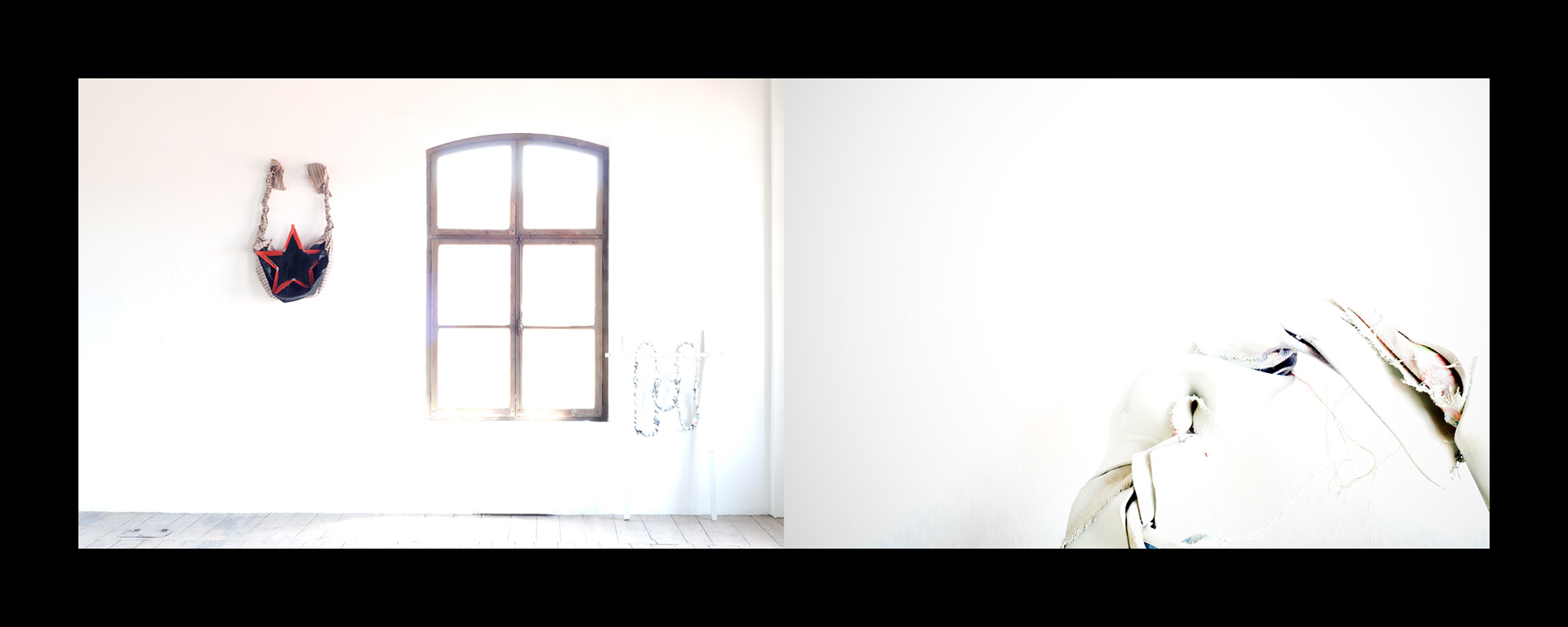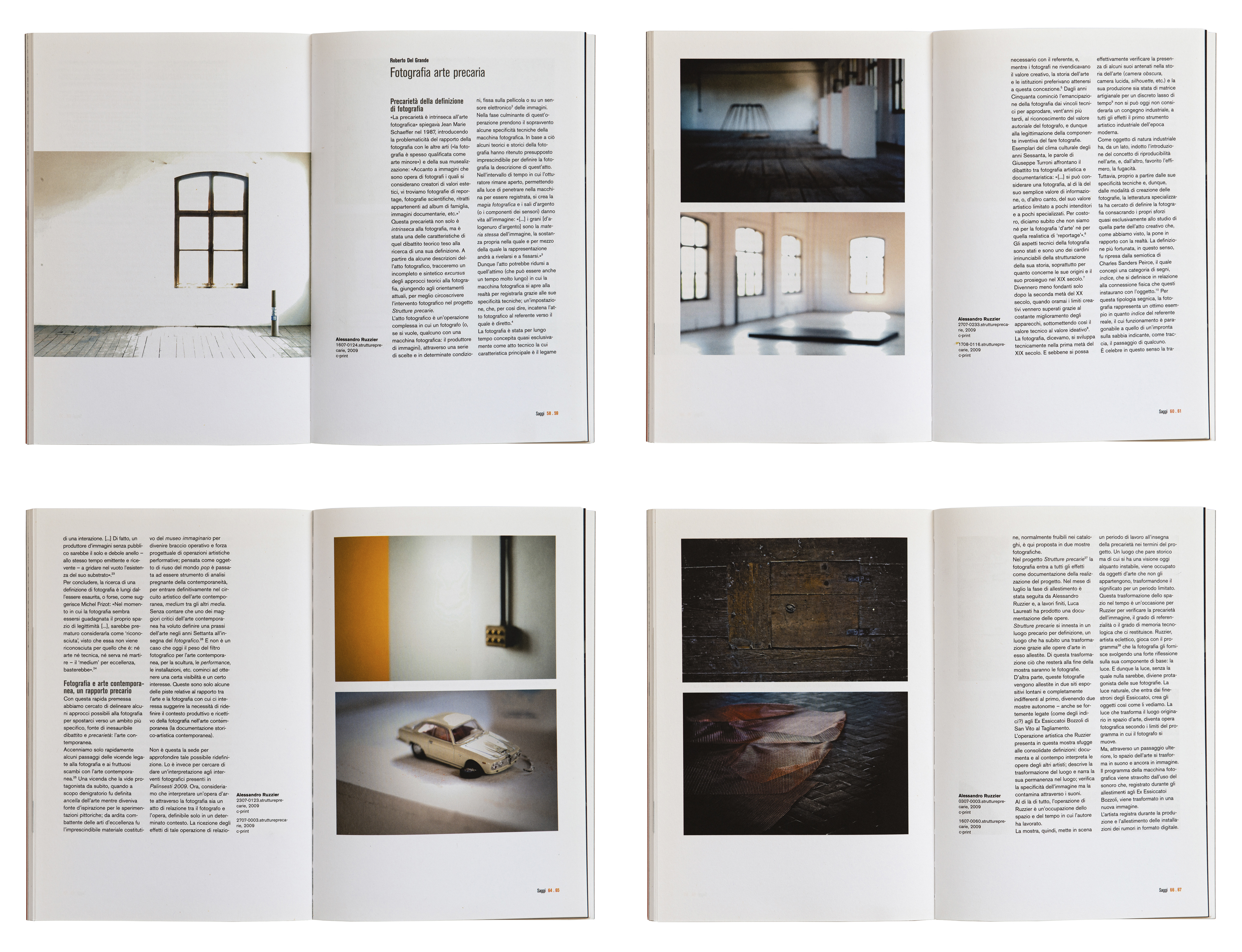





















STRUTTURE PRECARIE – Palinsesti 2009
Fondazione Ado Furlan, Pordenone
a cura di Denis Viva e Roberto Del Grande
Fondazione Ado Furlan, Pordenone
a cura di Denis Viva e Roberto Del Grande
L'operazione artistica che Ruzzier presenta in questa mostra sfugge alle consolidate definizioni: documenta e al contempo interpreta le opere degli altri artisti; descrive la trasformazione del luogo e narra la sua permanenza nel luogo; verifica la specificità dell'immagine ma la contamina attraverso i suoni. Al di là di tutto, l'operazione di Ruzzier è un'occupazione dello spazio e del tempo in cui l'autore ha lavorato. La mostra, quindi, mette in scena un periodo di lavoro all'insegna della precarietà nei termini del progetto. Un luogo che pare storico ma di cui si ha una visione oggi alquanto instabile, viene occupato da oggetti d'arte che non gli appartengono, trasformandone il significato per un periodo limitato. Questa trasformazione dello spazio nel tempo è un'occasione per Ruzzier per verificare la precarietà dell'immagine, il grado di referenzialità o il grado di memoria tecnologica che ci restituisce. Ruzzier, artista eclettico, gioca con il programma che la fotografia gli fornisce svolgendo una forte riflessione sulla sua componente di base: la luce. E dunque la luce, senza la quale nulla sarebbe, diviene protagonista delle sue fotografie. La luce naturale, che entra dai finestroni degli Essiccatoi, crea gli oggetti così come li vediamo. La luce che trasforma il luogo originario in spazio d'arte, diventa opera fotografica secondo i limiti del programma in cui il fotografo si muove. Ma, attraverso un passaggio ulteriore, lo spazio dell'arte si trasforma in suono e ancora in immagine. Il programma della macchina fotografica viene stravolto dall'uso del sonoro che, registrato durante gli allestimenti agli Ex-essiccatoi “bozzoli”, viene trasformato in una nuova immagine.
L'artista registra durante la produzione e l'allestimento delle installazioni dei rumori in formato digitale. Poi, elabora i rumori registrati separando lo spettro sonoro e usando le frequenze basse per generare note precise che, inviate ad un woofer impermeabilizzato e immerso nell'acqua, formeranno un'immagine sulla superficie che corrisponde alla frequenza stessa delle onde sonore.
I suoni dovuti alle frequenze medio-alte vengono editati e ricomposti come in una partitura musicale, elementi compositivi di una poetica narrativa che segue temporalmente l'inestinguibile ciclo della luce.
I rumori, come la luce, passano attraverso uno strumento di registrazione, vengono estrapolati dal continuum della realtà e vengono riconsegnati a noi nella mostra in forma di nuova realtà. L'immagine non si crea più attraverso la fotografia ma attraverso il suono. I media si fondono e si confondono per ricreare lo spazio esperito dal fotografo, in un tempo e in un luogo determinati dal progetto della mostra, e dilatati nella ricreazione del progetto artistico nello spazio espositivo di Pordenone.
L'artista registra durante la produzione e l'allestimento delle installazioni dei rumori in formato digitale. Poi, elabora i rumori registrati separando lo spettro sonoro e usando le frequenze basse per generare note precise che, inviate ad un woofer impermeabilizzato e immerso nell'acqua, formeranno un'immagine sulla superficie che corrisponde alla frequenza stessa delle onde sonore.
I suoni dovuti alle frequenze medio-alte vengono editati e ricomposti come in una partitura musicale, elementi compositivi di una poetica narrativa che segue temporalmente l'inestinguibile ciclo della luce.
I rumori, come la luce, passano attraverso uno strumento di registrazione, vengono estrapolati dal continuum della realtà e vengono riconsegnati a noi nella mostra in forma di nuova realtà. L'immagine non si crea più attraverso la fotografia ma attraverso il suono. I media si fondono e si confondono per ricreare lo spazio esperito dal fotografo, in un tempo e in un luogo determinati dal progetto della mostra, e dilatati nella ricreazione del progetto artistico nello spazio espositivo di Pordenone.
The artistic operation Ruzzier presents in this exhibition breaks away from consolidated definitions: it documents and simultaneously interprets the works of other artists; it describes the transformation of the place and narrates his presence there; it assesses the specificity of an image but it also contaminates it through sounds.
Besides everything else, Ruzzier's operation is the occupancy of the space and time in which the author worked. The exhibition stages therefore a work period marked by the precariousness of the project terms. Art objects that do not belong to an apparently historic place, but perceived today as rather instable, transform its meaning for a limited time. This transformation of the space in time presents an opportunity for Ruzzier to verify the precariousness of the image, its degree of self-reference, and the degree of technological memory it conveys. Ruzzier, an eclectic artist, plays with the program photography gives him, and develops a meaningful reflection on light, photography's basic component. And light, without which nothing would exist, becomes the protagonist of his photos.
Natural light, penetrating through the large windows of the Essiccatoi, creates objects as we see them. Light transforms the original setting in a place of art, it becomes a photographic work within the boundaries of the program in which the photographer works.
Yet, at the next stage, the space of art transforms itself into sound, and then once again into image. The camera's program is turned around with the use of a soundtrack which, recorded during the setting up stage at the former Essiccatoi "Bozzoli", is then transformed into a new image.
The artist records noises in digital format during the production and setting up of the installations. Then, he elaborates the recorded sounds dividing the sound spectrum and using low frequencies to generate specific notes which, sent to a waterproof woofer immersed in water, create an image on the surface corresponding to the frequency of the sound waves.
The sounds of medium-high frequencies are edited and recomposed as in sheet music, as components of narrative poetics temporally following the endless cycle of light. The noises, like the light, are filtered through a recording instrument; they are extrapolated from the continuum of reality and then returned to us in the exhibition in the form of new realities. The image is no longer a product of photography, rather of sound. Media are merged and blurred to recreate a space experienced by the photographer, in a given time and space of the exhibition's project, and expanded in the recreation of the artistic project in the exhibition hall in Pordenone.
Besides everything else, Ruzzier's operation is the occupancy of the space and time in which the author worked. The exhibition stages therefore a work period marked by the precariousness of the project terms. Art objects that do not belong to an apparently historic place, but perceived today as rather instable, transform its meaning for a limited time. This transformation of the space in time presents an opportunity for Ruzzier to verify the precariousness of the image, its degree of self-reference, and the degree of technological memory it conveys. Ruzzier, an eclectic artist, plays with the program photography gives him, and develops a meaningful reflection on light, photography's basic component. And light, without which nothing would exist, becomes the protagonist of his photos.
Natural light, penetrating through the large windows of the Essiccatoi, creates objects as we see them. Light transforms the original setting in a place of art, it becomes a photographic work within the boundaries of the program in which the photographer works.
Yet, at the next stage, the space of art transforms itself into sound, and then once again into image. The camera's program is turned around with the use of a soundtrack which, recorded during the setting up stage at the former Essiccatoi "Bozzoli", is then transformed into a new image.
The artist records noises in digital format during the production and setting up of the installations. Then, he elaborates the recorded sounds dividing the sound spectrum and using low frequencies to generate specific notes which, sent to a waterproof woofer immersed in water, create an image on the surface corresponding to the frequency of the sound waves.
The sounds of medium-high frequencies are edited and recomposed as in sheet music, as components of narrative poetics temporally following the endless cycle of light. The noises, like the light, are filtered through a recording instrument; they are extrapolated from the continuum of reality and then returned to us in the exhibition in the form of new realities. The image is no longer a product of photography, rather of sound. Media are merged and blurred to recreate a space experienced by the photographer, in a given time and space of the exhibition's project, and expanded in the recreation of the artistic project in the exhibition hall in Pordenone.
info@alessandroruzzier.it | phone +39 333 43 77 770
all rights reserved © copyright Alessandro Ruzzier 2025 – P.I. 01171860313
all rights reserved © copyright Alessandro Ruzzier 2025 – P.I. 01171860313